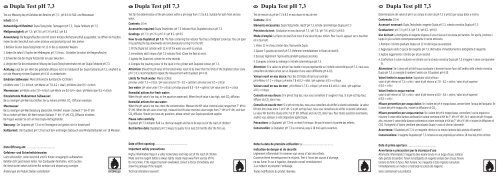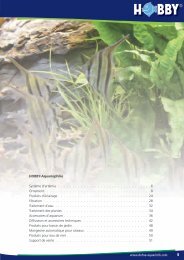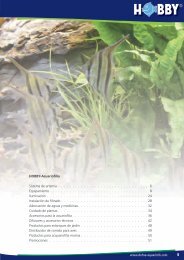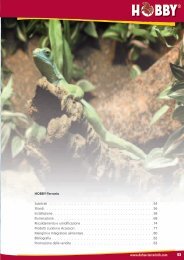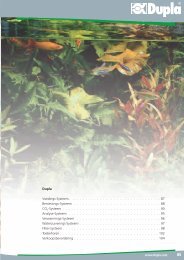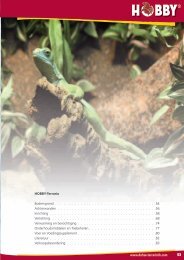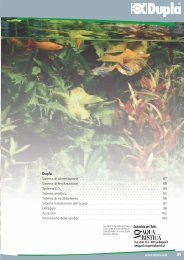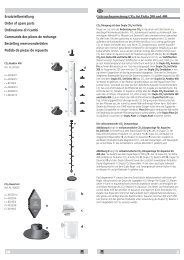Dupla Test pH 7,3 - Dohse Aquaristik KG
Dupla Test pH 7,3 - Dohse Aquaristik KG
Dupla Test pH 7,3 - Dohse Aquaristik KG
Create successful ePaper yourself
Turn your PDF publications into a flip-book with our unique Google optimized e-Paper software.
<strong>Dupla</strong> <strong>Test</strong> <strong>pH</strong> 7,3<br />
<strong>Test</strong> zur Messung des <strong>pH</strong>-Gehaltes der Bereiche <strong>pH</strong> 7,3 – <strong>pH</strong> 8,5 für Süß- und Meerwasser<br />
Inhalt: 10 ml<br />
Notwendige Hilfsmittel: <strong>Dupla</strong> <strong>Test</strong>zylinder, <strong>Test</strong>reagenz <strong>pH</strong> 7,3, <strong>Dupla</strong> Farbkarte <strong>pH</strong> 7,3<br />
Meßgenauigkeit: <strong>pH</strong> 7,3 / <strong>pH</strong> 7,6 / <strong>pH</strong> 7,9 / <strong>pH</strong> 8,2 / <strong>pH</strong> 8,5<br />
Anwendung: Die Reagenzfl aschen sind mit einem Kindersicherheitsverschluß ausgestattet. Sie öffnen die Flaschen,<br />
indem Sie den Verschluß nach unten drücken und gleichzeitig nach links drehen.<br />
1. Befüllen Sie den <strong>Dupla</strong> <strong>Test</strong>zylinder mit 12 ml des zu testenden Wassers.<br />
2. Geben Sie sofort 5 Tropfen der Meßreagenz <strong>pH</strong> 7,3 hinzu. (Schließen Sie sofort die Reagenzfl asche)<br />
3. Schwenken Sie den <strong>Dupla</strong> <strong>Test</strong>zylinder ein paar Sekunden.<br />
4. Vergleichen Sie die entstandene Färbung des <strong>Dupla</strong> <strong>Test</strong>zylinderinhaltes mit der <strong>Dupla</strong> Farbkarte <strong>pH</strong> 7,3.<br />
Achtung: Liegt der <strong>pH</strong>- Wert des getesteten Wassers nicht im Farbbereich der <strong>Dupla</strong> Farbkarte <strong>pH</strong> 7,3, empfi ehlt es<br />
sich die Messung mit dem <strong>Dupla</strong>test <strong>pH</strong> 4-10 zu wiederholen.<br />
Eckdaten Süßwasser: Meist afrikanische Buntbarsche (Cichliden)<br />
<strong>pH</strong>-Werte unter 7,3 = kritisch / <strong>pH</strong>-Werte um 7,8–8,2 = ideal / <strong>pH</strong>-Werte über 8,5 = kritisch<br />
Meerwasser: <strong>pH</strong>-Werte unter 7,8 = kritisch / <strong>pH</strong>-Werte um 8,0–8,4 = ideal / <strong>pH</strong>-Werte über 8,5 = kritisch<br />
Einzuleitende Maßnahmen Süßwasser:<br />
Bei zu niedrigem <strong>pH</strong>-Wert durchlüften. Bei zu hohem <strong>pH</strong>-Wert CO -Diffusion einsetzen.<br />
2<br />
Meerwasser:<br />
Bei zu niedrigem <strong>pH</strong>-Wert Belastung überprüfen. KH-Wert messen ( Sollwert 7° dH–9° dH)<br />
Bei zu hohem <strong>pH</strong>-Wert, KH-Wert messen (Sollwert 7° dH– 9° dH), CO -Diffusion einsetzen.<br />
2<br />
Bei Fragen wenden Sie sich an Ihren <strong>Dupla</strong>-Vertragshändler.<br />
Warnung: Der <strong>Dupla</strong>test <strong>pH</strong> 7,3 ist ein <strong>Test</strong>reagenz und gehört nicht in Kinderhand!<br />
Haltbarkeit: Der <strong>Dupla</strong>test <strong>pH</strong> 7,3 hat nach dem erstmaligen Gebrauch eine Mindesthaltbarkeit von 18 Monaten.<br />
Erste Öffnung am: ………………………………<br />
Gefahren- und Sicherheitshinweise:<br />
Leicht entzündlich. Unter Verschluß und für Kinder unzugänglich aufbewahren.<br />
Behälter dicht geschlossen halten. Von Zündquellen fernhalten, nicht rauchen.<br />
Bei Verschlucken sofort ärztlichen Rat einholen und Verpackung vorzeigen.<br />
Änderungen am Produkt bleiben vorbehalten!<br />
<strong>Dupla</strong> <strong>Test</strong> <strong>pH</strong> 7,3<br />
<strong>Test</strong> for the determination of the <strong>pH</strong> content within a <strong>pH</strong> range from 7.3 to 8.5. Suitable for both fresh and sea<br />
water.<br />
Contents: 10 ml<br />
Accessories required: <strong>Dupla</strong> <strong>Test</strong>zylinder, <strong>pH</strong> 7.3 indicator fl uid, <strong>Dupla</strong>test colours <strong>pH</strong> 7.3<br />
Gradings: <strong>pH</strong> 7.3 / <strong>pH</strong> 7.6 / <strong>pH</strong> 7.9 / <strong>pH</strong> 8.2 / <strong>pH</strong> 8.5<br />
How to use <strong>Dupla</strong>test <strong>pH</strong> 7.3: The fl ask containing the indicator fl uid has a childproof screw top. You can open<br />
it by pushing the top downwards and simultaneously turning it to the left.<br />
1. Fill the <strong>Dupla</strong> test cylinder with 12 ml of the water you wish to analyze.<br />
2. Immediately add 5 drops of <strong>pH</strong> 7.3 indicator fl uid. (Close the fl ask at once).<br />
3. Agitate the <strong>Dupla</strong> test cylinder for a few seconds.<br />
4. Compare the resulting colour of the liquid in the cylinder with <strong>Dupla</strong>test colours <strong>pH</strong> 7.3.<br />
Attention: Should the <strong>pH</strong> value of the tested water result to be lower than the limits of the <strong>Dupla</strong>test colour scale<br />
<strong>pH</strong> 7.3 it is recommended to repeat the measurement with <strong>Dupla</strong>test <strong>pH</strong> 4-10.<br />
Limits for fresh water: Mainly cichlids<br />
<strong>pH</strong> value under 7.3 = critical / <strong>pH</strong> value around 7.8 – 8.2 = optimal / <strong>pH</strong> value over 8.5 = critical<br />
Sea water: <strong>pH</strong> value under 7.8 = critical / <strong>pH</strong> value around 8.0 – 8.4 = optimal / <strong>pH</strong> value over 8.5 = critical<br />
Remedial actions for fresh water:<br />
When the <strong>pH</strong> value is too low, air the aquarium water well. When the <strong>pH</strong> value is too high, start CO diffusion.<br />
2<br />
Remedial actions for sea water:<br />
When the <strong>pH</strong> value is too low, check the contamination. Measure the KH value (nominal value ranges from 7° dH to<br />
9° dH). When the <strong>pH</strong> value is too high, measure the KH value (nominal value ranges from 7° dH to 9° dH), and start<br />
CO diffusion. Should you have any questions, please consult your <strong>Dupla</strong>-specialized supplier.<br />
2<br />
Please note carefully:<br />
<strong>Dupla</strong>test <strong>pH</strong> 7.3 indicator fl uid is a chemical reagent and has to be kept out of the reach of children!<br />
Best-before date: <strong>Dupla</strong>test <strong>pH</strong> 7.3 keeps its quality for at least 18 months after the fi rst use.<br />
Date of fi rst opening:.................................................<br />
Important safety precautions:<br />
Highly infl ammable! Keep in a safely locked place and keep out of the reach of children.<br />
Make sure the reagent bottle is always tightly closed. Keep away from sources of fi re.<br />
Do not smoke. If the reagent has been swallowed, consult a doctor immediately and<br />
show the package of the reagent.<br />
Technical alterations reserved!<br />
<strong>Dupla</strong> <strong>Test</strong> <strong>pH</strong> 7,3<br />
<strong>Test</strong> de mesure du <strong>pH</strong> de 7.3 à 8.5 en eau douce et eau de mer.<br />
Contenu: 10 ml<br />
Eléments nécessaires: <strong>Dupla</strong> <strong>Test</strong>zylinder, réactif <strong>pH</strong> 7.3, échelle colorimétrique <strong>Dupla</strong> <strong>pH</strong> 7.3<br />
Précision du test: Graduation en eau douce <strong>pH</strong> 7.3 / <strong>pH</strong> 7.6 / <strong>pH</strong> 7.9 / <strong>pH</strong> 8.2 / <strong>pH</strong> 8.5<br />
Mode d’emploi: Le fl acon de réactif est muni d’une sécurité pour enfant. Pour l’ouvrir, appuyer sur le bouchon<br />
en le tournant.<br />
1. Verser 12 ml d’eau à tester dans l’éprouvette <strong>Dupla</strong>.<br />
2. Ajouter 5 gouttes de réactif <strong>pH</strong> 7.3 (Refermer immédiatement le fl acon de réactif).<br />
3. Secouez légèrement l’éprouvette pendant quelques secondes.<br />
4. Comparez la teinte du mélange à l’échelle colorimétrique <strong>pH</strong> 7.3.<br />
Attention! Si la valeur du <strong>pH</strong> de l’eau testée n’est pas représentée sur l’échelle colorimétrique <strong>pH</strong> 7.3, nous vous<br />
conseillons de refaire le test sur un <strong>Dupla</strong>test d’une valeur différente (<strong>pH</strong> 4-10).<br />
Valeurs-seuil en eau douce: Pour des Cichlidés africains par exemple:<br />
<strong>pH</strong> inférieur à 7.3 = critique / <strong>pH</strong> entre 7.8 et 8.2 = idéal / <strong>pH</strong> supérieur à 8.5 = critique<br />
Valeurs-seuil en eau de mer: <strong>pH</strong> inférieur à 7.8 = critique / <strong>pH</strong> entre 8.0 et 8.4 = idéal / <strong>pH</strong> supérieur<br />
à 8.5 = critique<br />
Conseils en eau douce: Si le <strong>pH</strong> est trop bas, nous vous conseillons d’ oxygéner l’eau. Si le <strong>pH</strong> est trop haut,<br />
diffusez du CO dans l’eau.<br />
2<br />
Conseils en eau de mer: Si le <strong>pH</strong> est trop bas, nous vous conseillons de vérifi er la dureté carbonatée. La valeur<br />
KH doit être située entre 7 et 9° dH. Si le <strong>pH</strong> est trop haut, nous vous conseillons de vérifi er la dureté carbonatée.<br />
La valeur KH doit être située entre 7 et 9° dH. Diffusez alors du CO dans l’eau. Pour toutes questions éventuelles,<br />
2<br />
veuillez vous adresser à votre dépositaire agréé <strong>Dupla</strong>.<br />
Précautions: Le <strong>Dupla</strong>test <strong>pH</strong> 7.3 est un réactif chimique. Ne pas le laisser à la portée des enfants.<br />
Conservation: Le <strong>Dupla</strong>test <strong>pH</strong> 7.3 se conserve jusqu’à 18 mois après ouverture.<br />
Notez la date de première utilisation: Le .....................…………………<br />
Indication de danger et de sécurité<br />
Légèrement infl ammable! A conserver sous verrou à l’abri des enfants.<br />
Conserver fermé hermétiquement le récipient. Tenir à l’ecart des sources d’allumage,<br />
ne pas fumer. En cas d’ingestion, demander conseil immédiatement<br />
à un médecin et présenter l’em ballage.<br />
Toutes modifi cations du produit réservées.<br />
<strong>Dupla</strong> <strong>Test</strong> <strong>pH</strong> 7,3<br />
Determinazione del valore di <strong>pH</strong> in un campo di valori da <strong>pH</strong> 7,3 a <strong>pH</strong> 8,5 per acqua dolce e marina<br />
Contenuto: 10 ml<br />
Accessori necessari: <strong>Dupla</strong> <strong>Test</strong>zylinder, reagente <strong>Dupla</strong> <strong>pH</strong> 7,3, scheda cromatica <strong>Dupla</strong> <strong>pH</strong> 7,3<br />
Graduazioni: <strong>pH</strong> 7,3 / <strong>pH</strong> 7,6 / <strong>pH</strong> 7,9 / <strong>pH</strong> 8,2 / <strong>pH</strong> 8,5<br />
Uso del test: La bottiglietta di reagente dispone di una chiusura di sicurezza per bambini. Per aprirla, premere il<br />
tappo in giù e svitarlo contemporaneamente in senso antiorario.<br />
1. Riempire il cilindro graduato <strong>Dupla</strong> con 12 ml dell’acqua da analizzare.<br />
2. Aggiungere subito 5 gocce del reagente <strong>pH</strong> 7,3. (Richiudere immediatamente la bottiglietta di reagente)<br />
3. Agitare leggermente il cilindro per alcuni secondi.<br />
4. Confrontare il colore risultante nel cilindro con la scheda cromatica <strong>Dupla</strong> <strong>pH</strong> 7,3 e leggere il valore corrispondente.<br />
Attenzione! Se il valore del <strong>pH</strong> dell’acqua analizzata si dovesse trovare fuori dall’ambito della scheda cromatica<br />
<strong>Dupla</strong> <strong>pH</strong> 7,3, si consiglia di ripetere l’analisi con il <strong>Dupla</strong>test <strong>pH</strong> 4-10.<br />
Valori limite in acqua dolce: Sopratutto ciclidi africani<br />
valori di <strong>pH</strong> inferiori di 7,3 = critici / valori di <strong>pH</strong> intorno ai 7,8 – 8,2 = ottimi / valori di <strong>pH</strong> superiori<br />
di 8,5 = critici<br />
Valori limite in acqua marina:<br />
valori di <strong>pH</strong> inferiori di 7,8 = critici / valori di <strong>pH</strong> intorno ai 8,0 – 8,4 = ottimi / valori di <strong>pH</strong> superiori<br />
di 8,5 = critici<br />
Misure preventive per acqua dolce: Se il valore del <strong>pH</strong> è troppo basso, aereare bene l’acqua dell’acquario. Se<br />
il valore del <strong>pH</strong> è troppo alto, iniziare la diffusione di CO . 2<br />
Misure preventive per acqua marina: Se il valore del <strong>pH</strong> è troppo basso, controllare il carico organico e<br />
misurare il valore della durezza carbonatica (valore nominale di KH da 7° dH a 9° dH). Se il valore del <strong>pH</strong> è troppo<br />
alto, misurare il valore della durezza carbonatica (valore nominale di KH da 7° dH a 9° dH) e iniziare la diffusione di<br />
CO2. RivolgeteVi al Vostro venditore specializzato <strong>Dupla</strong> in caso di ulteriori domande.<br />
Avvertenza: Il <strong>Dupla</strong>test <strong>pH</strong> 7,3 è un reagente chimico e va tenuto lontano dalla portata di bambini!<br />
Conservazione: Il reagente <strong>Dupla</strong>test <strong>pH</strong> 7,3 conserva le sue proprietà per almeno 18 mesi dal primo utilizzo.<br />
Data di prima apertura:............................................<br />
Avvertenze e precauzioni per la sicurezza d’uso<br />
Altamente infi ammabile! Il reagente deve essere tenuto in un luogo chiuso, lontano<br />
dalla portata di bambini. Tenere la bottiglietta di reagente sempre ben chiusa. Tenere<br />
lontano da fonti di fuoco. Non fumare. Se il reagente è stato ingoiato consultare<br />
immediatamente un medico e mostrargli la scatola del reagente.<br />
Salvo cambiamenti sul prodotto!


